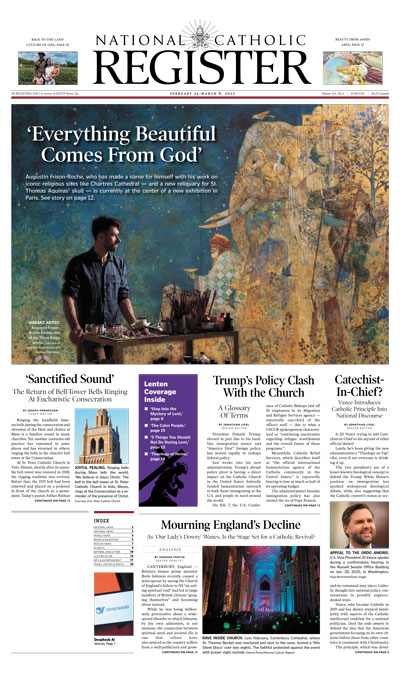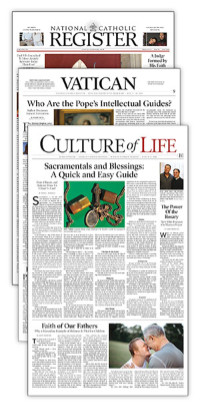St. John Vianney Feast Day
Today marks the 150th anniversary of the death of St. John Vianney — the famous Curé of Ars.
The anniversary is especially significant, in light of Pope Benedict XVI’s decision to specifically link the Church’s current Year for Priests to this anniversary of St. John Vianney’s death and to highlight him as the model for the priests of today.
Said the Pope in the Letter to Priests he released in proclamation of the Year for Priests:
In his time the Curé of Ars was able to transform the hearts and the lives of so many people because he enabled them to experience the Lord’s merciful love. Our own time urgently needs a similar proclamation and witness to the truth of Love: Deus Caritas Est (1 John: 4:8). Thanks to the word and the sacraments of Jesus, John Mary Vianney built up his flock, although he often trembled from a conviction of his personal inadequacy and desired more than once to withdraw from the responsibilities of the parish ministry out of a sense of his unworthiness. Nonetheless, with exemplary obedience, he never abandoned his post, consumed as he was by apostolic zeal for the salvation of souls. He sought to remain completely faithful to his own vocation and mission through the practice of an austere asceticism: “The great misfortune for us parish priests — he lamented — is that our souls grow tepid”; meaning by this that a pastor can grow dangerously inured to the state of sin or of indifference in which so many of his flock are living. 30 He himself kept a tight rein on his body, with vigils and fasts, lest it rebel against his priestly soul. Nor did he avoid self-mortification for the good of the souls in his care and as a help to expiating the many sins he heard in confession. To a priestly confrere he explained: “I will tell you my recipe: I give sinners a small penance and the rest I do in their place.” 31 Aside from the actual penances which the Curé of Ars practiced, the core of his teaching remains valid for each of us: Souls have been won at the price of Jesus’ own blood, and a priest cannot devote himself to their salvation if he refuses to share personally in the “precious cost” of redemption.
In today’s world, as in the troubled times of the Curé of Ars, the lives and activity of priests need to be distinguished by a forceful witness to the Gospel. As Pope Paul VI rightly noted, “Modern man listens more willingly to witnesses than to teachers, and if he does listen to teachers, it is because they are witnesses.“32 Lest we experience existential emptiness and the effectiveness of our ministry be compromised, we need to ask ourselves ever anew: “Are we truly pervaded by the word of God? Is that word truly the nourishment we live by, even more than bread and the things of this world? Do we really know that word? Do we love it? Are we deeply engaged with this word to the point that it really leaves a mark on our lives and shapes our thinking?” 33 Just as Jesus called the Twelve to be with him (Mark 3:14), and only later sent them forth to preach, so too in our days priests are called to assimilate that “new style of life” which was inaugurated by the Lord Jesus and taken up by the apostles. 34
It was complete commitment to this “new style of life” which marked the priestly ministry of the Curé of Ars. Pope John XXIII, in his encyclical letter Sacerdotii Nostri Primordia, published in 1959 on the first centenary of the death of Saint John Mary Vianney, presented his asceticism with special reference to the “three evangelical counsels” which the Pope considered necessary also for priests: “Even though priests are not bound to embrace these evangelical counsels by virtue of the clerical state, these counsels nonetheless offer them, as they do all the faithful, the surest road to the desired goal of Christian perfection.” 35 The Curé of Ars lived the “evangelical counsels” in a way suited to his priestly state. His poverty was not the poverty of a religious or a monk, but that proper to a priest: while managing much money (since well-to-do pilgrims naturally took an interest in his charitable works), he realized that everything had been donated to his church, his poor, his orphans, the girls of his “Providence,” 36 his families of modest means. Consequently, he “was rich in giving to others and very poor for himself.” 37 As he would explain: “My secret is simple: Give everything away; hold nothing back.” 38 When he lacked money, he would say amiably to the poor who knocked at his door: “Today I’m poor just like you, I’m one of you.” 39 At the end of his life, he could say with absolute tranquillity: “I no longer have anything. The good Lord can call me whenever he wants!” 40 His chastity, too, was that demanded of a priest for his ministry. It could be said that it was a chastity suited to one who must daily touch the Eucharist, who contemplates it blissfully and with that same bliss offers it to his flock. It was said of him that “he radiated chastity”; the faithful would see this when he turned and gazed at the tabernacle with loving eyes.” 41 Finally, St. John Mary Vianney’s obedience found full embodiment in his conscientious fidelity to the daily demands of his ministry. We know how he was tormented by the thought of his inadequacy for parish ministry and by a desire to flee “in order to bewail his poor life, in solitude.” 42 Only obedience and a thirst for souls convinced him to remain at his post. As he explained to himself and his flock: “There are no two good ways of serving God. There is only one: Serve him as he desires to be served.” 43 He considered this the golden rule for a life of obedience: “Do only what can be offered to the good Lord.” 44










